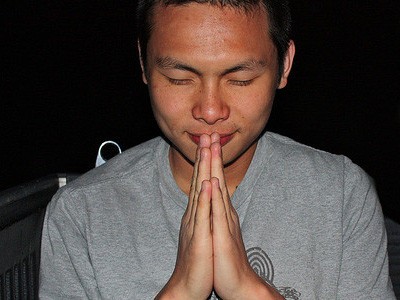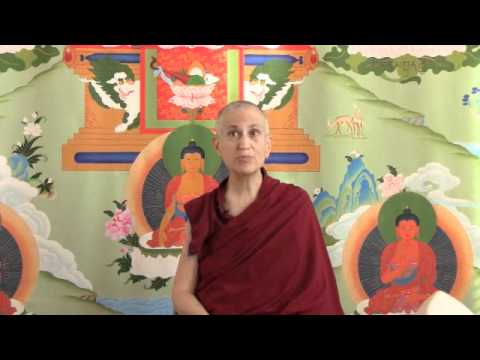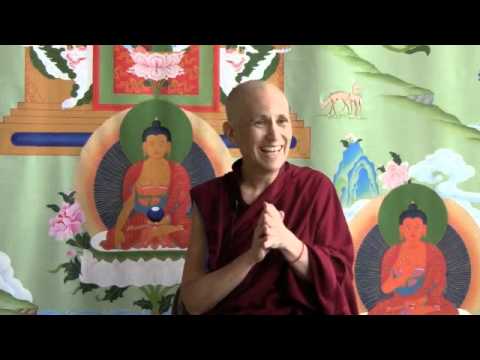Guidelines for the practice of refuge

Having taken refuge, a safe and sound direction in the Three Jewels—Buddha, Dharma, and Sangha—it is advantageous to follow certain guidelines for practice in order to make progress along the path to awakening.
- In analogy to taking refuge in the Buddha, commit yourself whole-heartedly to a qualified spiritual mentor.
- In analogy to taking refuge in the Dharma, listen to and study the teachings as well as put them into practice in your daily life.
- In analogy to taking refuge in the Sangha, respect the Sangha as your spiritual companions and follow the good examples they set.
- Avoid being rough and arrogant, running after any desirable object you see and criticizing anything that meets with your disapproval.
- Be friendly and kind to others and be concerned more with correcting your own faults than with pointing out those of others.
- As much as possible avoid the ten non-virtuous actions,1 and take and keep precepts.2
- Have a compassionate and sympathetic heart towards all other sentient beings.
- Make special offerings to the Three Jewels on Buddhist festival days.
Guidelines in terms of each of the Three Jewels
- Having taken refuge in the Buddha, who has purified all defilements and developed all excellent qualities, do not turn for refuge to worldly deities, who lack the capacity to guide you from all problems.
Respect all images of the Buddha: do not put them in low or dirty places, step over them, point your feet towards them, sell them to earn a living or use them as collateral. When looking at various images, do not discriminate, “This Buddha is beautiful, but this one is not.” Do not treat with respect expensive and impressive statues while neglecting those that are damaged or less costly.
- Having taken refuge in the Dharma, avoid harming any living being.
Also, respect the written words which describe the path to awakening by keeping the texts clean and in a high place. Avoid stepping over them, putting them on the floor, or throwing them in the rubbish when they are old. It is best to burn or recycle old Dharma materials.
- Having taken refuge in the Sangha, do not cultivate the friendship of people who criticize the Buddha, Dharma, and Sangha or who have unruly behavior or do many harmful actions. By becoming friendly with such people, you may be influenced in the wrong way by them. However, that does not mean you should criticize or not have compassion for them.
Also, respect monks and nuns as they are people who are making earnest efforts to actualize the teachings. Respecting them helps your mind, for you appreciate their qualities and are open to learn from their example. By respecting even the robes of ordained beings, you will be happy and inspired when seeing them.
Common guidelines
- Mindful of the qualities, skills, and differences between the Three Jewels and other possible refuges, repeatedly take refuge in the Buddha, Dharma and Sangha.
- Remembering their kindness, make offerings to them, especially offering your food before eating. (See the prayers for this.)
- Mindful of their compassion, encourage others to take refuge in the Three Jewels.
- Remembering the benefits of taking refuge, do so three times in the morning and three times in the evening, by reciting and reflecting upon any of the refuge prayers.
- Do all actions by entrusting yourself to the Three Jewels.
- Do not forsake your refuge at the cost of your life, or even as a joke.
The ten non-virtuous actions are: killing, stealing, sexual misconduct (three of the body); lying, divisive speech, harsh words, idle talk, (four of speech); covetousness, maliciousness, and wrong views (three of mind). ↩
For a lay person, one can take the eight Mahayana precepts for one day, or one can take some or all of the five precepts for the duration of one’s life. On the basis of refuge, a lay person may also take the bodhisattva precepts and tantric vows. ↩
Venerable Thubten Chodron
Venerable Chodron emphasizes the practical application of Buddha’s teachings in our daily lives and is especially skilled at explaining them in ways easily understood and practiced by Westerners. She is well known for her warm, humorous, and lucid teachings. She was ordained as a Buddhist nun in 1977 by Kyabje Ling Rinpoche in Dharamsala, India, and in 1986 she received bhikshuni (full) ordination in Taiwan. Read her full bio.


